高中英语语法——过去分词作状语
高中英语Module5EthnicCultureSectionⅢGrammar—过去分词作状语短语动词教案(含解析)外研版选修7

Section Ⅲ Grammar —过去分词作状语短语动词语法图解探究发现①Seen from above, the old town is a maze of canals, little bridges and tiny cobbled streets that tourists get lost in.②Not invited, he became very disappointed.③Completely rebuilt, the town would not be so interesting.④Beaten by the opposite team, we didn't lose heart and encouraged each other.⑤Aunt Wu came in, followed by her daughter.⑥The old town is on the side of a mountain and opposite it is the 5,500 metre Yulong Xueshan Mountain, its peak covered with snow.⑦A big fire broke out last night in that village.⑧When he read the book, he came across many new words.[我的发现](1)①~⑤句中,黑体部分均在句中作状语,分别表示时间、原因、条件、让步、伴随。
(2)由②句可知,过去分词作状语时,其否定形式通常是在过去分词前加not。
(3)⑥句中分词作状语,有自己独立的主语,这叫独立主格结构。
(4)⑦⑧句中黑体部分为短语动词。
一、过去分词(短语)作状语1.过去分词(短语)在句中作状语,可以表示时间、原因、条件、伴随、方式、让步、结果。
2.过去分词(短语)在句中作状语表示动作的完成和被动。
人教版高中英语:Unit 3 Life in the future 语法归纳 过去分词作状语和定语
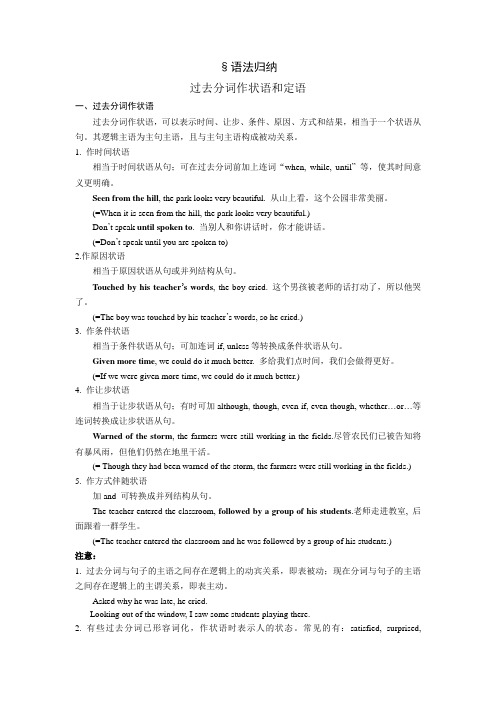
§语法归纳过去分词作状语和定语一、过去分词作状语过去分词作状语,可以表示时间、让步、条件、原因、方式和结果,相当于一个状语从句。
其逻辑主语为主句主语,且与主句主语构成被动关系。
1. 作时间状语相当于时间状语从句;可在过去分词前加上连词“when, while, until”等,使其时间意义更明确。
Seen from the hill, the park looks very beautiful. 从山上看,这个公园非常美丽。
(=When it is seen from the hill, the park looks very beautiful.)Don’t speak until spoken to. 当别人和你讲话时,你才能讲话。
(=Don’t speak until you are spoken to)2.作原因状语相当于原因状语从句或并列结构从句。
Touched by his teacher’s words, the boy cried. 这个男孩被老师的话打动了,所以他哭了。
(=The boy was touched by his teacher’s words, so he cried.)3. 作条件状语相当于条件状语从句;可加连词if, unless等转换成条件状语从句。
Given more time, we could do it much better. 多给我们点时间,我们会做得更好。
(=If we were given more time, we could do it much better.)4. 作让步状语相当于让步状语从句;有时可加although, though, even if, even though, whether…or…等连词转换成让步状语从句。
Warned of the storm, the farmers were still working in the fields.尽管农民们已被告知将有暴风雨,但他们仍然在地里干活。
高中英语语法—过去分词作状语讲义+练习题
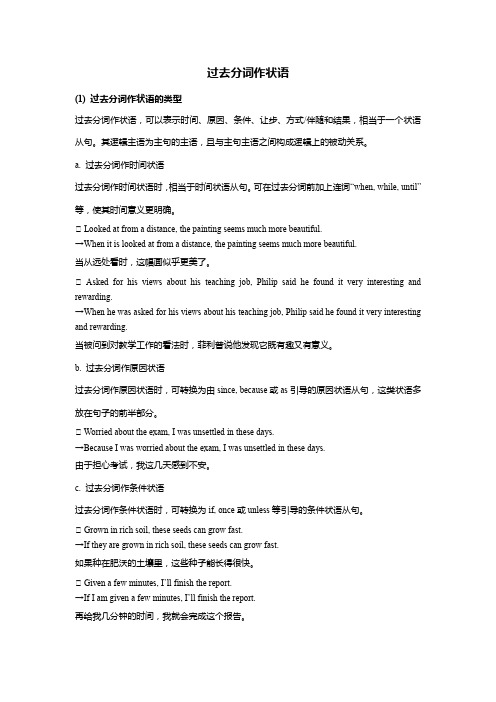
过去分词作状语(1) 过去分词作状语的类型过去分词作状语,可以表示时间、原因、条件、让步、方式/伴随和结果,相当于一个状语从句。
其逻辑主语为主句的主语,且与主句主语之间构成逻辑上的被动关系。
a. 过去分词作时间状语过去分词作时间状语时,相当于时间状语从句。
可在过去分词前加上连词“when, while, until”等,使其时间意义更明确。
◆ Looked at from a distance, the painting seems much more beautiful.→When it is looked at from a distance, the painting seems much more beautiful.当从远处看时,这幅画似乎更美了。
◆ Asked for his views about his teaching job, Philip said he found it very interesting and rewarding.→When he was asked for his views about his teaching job, Philip said he found it very interesting and rewarding.当被问到对教学工作的看法时,菲利普说他发现它既有趣又有意义。
b. 过去分词作原因状语过去分词作原因状语时,可转换为由since, because或as引导的原因状语从句,这类状语多放在句子的前半部分。
◆ Worried about the exam, I was unsettled in these days.→Because I was worried about the exam, I was unsettled in these days.由于担心考试,我这几天感到不安。
c. 过去分词作条件状语过去分词作条件状语时,可转换为if, once或unless等引导的条件状语从句。
高中英语语法——状语

6. Although they had been defeated many times, they continued to fight. (让步 让步) 让步 Although defeated many times, … 7. She begins to cry loudly as if she has/had been bitten by a snake. She begins to cry loudly as if bitten by a snake. (方式,as if 不能省略 方式, 不能省略) 方式 8. The woman scientist entered the lab, followed by her assistants. (伴随状语 没有状语从句可以代替 伴随状语,没有状语从句可以代替 伴随状语 没有状语从句可以代替)
Note 3: 习惯表达作插入语起评注说明作用,用 习惯表达作插入语起评注说明作用, 法固定,不必考虑逻辑上的关系,常用的有: 法固定,不必考虑逻辑上的关系,常用的有: generally / strictly speaking; judging from considering; given 考虑到 考虑到; supposing that; talking of 说到,谈到; 说到,谈到; seeing that 由于; 由于; Generally speaking, men can run faster than women. Given her interest in children, I'm sure teaching is the right career for her.
Hale Waihona Puke 分词作状语,可以补充完整为相应的状语从句 Ⅱ.分词作状语 可以补充完整为相应的状语从句 分词作状语 可以补充完整为相应的状语从句.
高考英语语法词汇专项突破:06表解过去分词作状语和定语与非谓语动词辨析+巩固训练

高考英语语法词汇专项突破:表解过去分词作状语和定语与非谓语动词辨析+巩固训练Part1:聚焦过去分词作状语和定语【高考链接1】everyone.答案与解析:intended。
考查非谓语动词之过去分词作定语be intended for打算为……所用,在句中作定语,所以用过去分词形式。
故填intended。
句意:然而,在简洁的风格背后,是每个人都想要传达的重要信息。
【考例2】(2022年浙江6月卷)Blind people recognize shapes with their existing senses, in a way similar to that of _____ (sight )people, says Ella Striem-Amit, a Harvard scientist.答案与解析:sighted。
考查形容词。
句意:哈佛高校的科学家埃拉·斯特里姆-阿米特(Ella Striem-Amit)说,盲人用他们现有的感官识别外形,在某种程度上与正常人相像。
形容词sighted作定语修饰名词people,表示“能观察的、不盲的”。
故填sighted。
【考例3】(2021浙江1月卷)Tn 1985,urban men and women in more than three quarters of the countries (study) had higher BMIs than men and women in rural areas.答案与解析:studied。
考查非谓语动词。
句意:1985年,在被争辩的国家中,超过四分之三的城市男性和女性的BMIs高于农村地区的男性和女性。
分析句子结构可知,句子的谓语是had,所以study用非谓语形式,它的规律主语是countries,表被动关系,应当使用过去分词作定语。
故填studied。
【高考链接2】1. (XXXX上海卷) The rare fish, _________ from the cooking pot, has been returned to the sea.A. savedB. savingC. to be savedD. having saved2.(XXXX·湖南卷)The players ______from the whole country are expected to bring us honor in this summer game .A. selectingB. to selectC. selectedD. having selected3.(XXXX·天津卷)______ into English, the sentence was found to have an entirely different word order.A. TranslatingB. TranslatedC. To translateD. Having translated4.( XXXX全国卷II 11)Though ______ to see us,the professor gave us a warm welcome。
高考英语 语法专题复习9 动词的非谓语形式试题精解

落堕市安心阳光实验学校语法专项(九) 动词的非谓语形式考点一过去分词作状语1.过去分词作状语,修饰谓语动词,说明谓语动词的动作或状态,即动作发生时的背景或状况;其逻辑主语通常就是句子的主语,且主语是过去分词动作的承受者,过去分词与主语之间存在被动关系。
Given the right kind of training, these teenage soccer players may one day grow into international stars.(这里give与句子的主语these teenage soccer players之间存在被动关系)给予正确的训练,这些青少年足球运动员有一天会成为国际明星。
[考题印证]—Can you introduce me a high quality machine?—My pleasure. ________(handle) well even on wet roads, this kind of car is very popular.解析:句意:——你能给我介绍一款高性能的机器吗?——我很乐意。
因为这款车即使在潮湿的道路上也能运行很好,所以很受欢迎。
handle和this kind of car是逻辑上的动宾关系,故用handle的ed形式。
答案:Handled2.某些动词的过去分词已经形容词化,且往往用于一些系表结构中,此时这些过去分词,只表示一种状态,如:lost(迷路的),seated(坐),hidden(躲),lost/absorbed in(沉溺于),dressed in(穿着),tired of(感到厌倦)等,不管它们作什么成分都不用其ing形式。
Absorbed in his book, he didn't notice me enter the room.专心于读书,他没注意到我进入房间。
Dressed in red, she looks more beautiful.穿着红色的衣服,她看上去更漂亮了。
英语语法--过去分词作状语(含练习)

2 作时间状语,等于when 引导时间从句,如果分词表示的动 作与谓语的动作同时发生,可在分词前加when/ while / until 等使时间意义更明确。 When heated , water can be changed into steam . Seen from the hill ,the park looks very beautiful .= ( When the park is seen from the hill…
语法:Past Participle As the adverbial 过去分作状语
3 作条件状语等于 if / whether 引导从句 Given more attention , the cabbages could have grown better .= ( If they have been given more attention …. Compared with you , we still have a long way to go = ( If we are compared with you …
United States .
A Being founded
B It was founded
C Founded
D Founding
3 Unless C__to speak ,you should remain silent at the conference .
A invited
非谓语动词用法解析过去分词作状语

非谓语动词用法解析过去分词作状语非谓语动词用法解析——过去分词作状语过去分词作为一种非谓语动词形式,在英语语法中扮演着重要的角色。
它可以作为状语,修饰动词、形容词以及副词,起到更加精确和丰富的表达作用。
本文将对过去分词作状语的用法进行解析,并举例说明其在不同语境下的运用。
1. 过去分词作时间状语过去分词可以表示一个动作或状态的发生时间,常用于表示被动或完成的行为。
这种用法通常与表示时间的介词短语(如"after"、"before"、"since"、"when"、"while"等)搭配使用。
例1:Having finished her work, she went out for a walk.(完成了工作后,她出去散步了。
)例2:After being repaired, the car was as good as new.(修好后,这辆车好像新的一样。
)2. 过去分词作原因状语过去分词也可以表示一个动作或状态的原因。
它常用于表示被动、先行动作和结果的关系,通常与表示原因的介词短语(如"because of"、"due to"、"thanks to"等)搭配使用。
例1:Because of the heavy rain, the game was canceled.(因为下大雨,比赛被取消了。
)例2:Due to his hard work, he achieved great success.(由于他的努力,他取得了巨大的成功。
)3. 过去分词作方式状语过去分词还可以表示一个动作的方式或方式。
它常与表示方式的介词短语(如"by")或连词(如"as")搭配使用。
例1:He won the race by running faster than others.(他通过比其他人跑得更快赢得了比赛。
高中英语知识点归纳分词作状语的常见形式
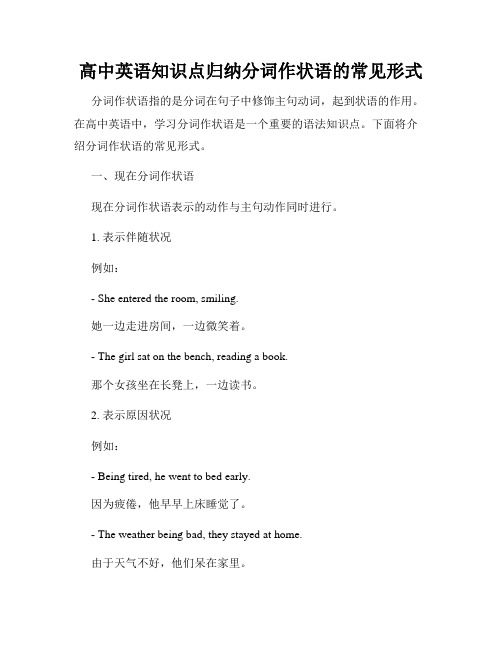
高中英语知识点归纳分词作状语的常见形式分词作状语指的是分词在句子中修饰主句动词,起到状语的作用。
在高中英语中,学习分词作状语是一个重要的语法知识点。
下面将介绍分词作状语的常见形式。
一、现在分词作状语现在分词作状语表示的动作与主句动作同时进行。
1. 表示伴随状况例如:- She entered the room, smiling.她一边走进房间,一边微笑着。
- The girl sat on the bench, reading a book.那个女孩坐在长凳上,一边读书。
2. 表示原因状况例如:- Being tired, he went to bed early.因为疲倦,他早早上床睡觉了。
- The weather being bad, they stayed at home.由于天气不好,他们呆在家里。
3. 表示条件状况例如:- I will go to the park, weather permitting.天气允许的话,我会去公园。
- We went out, the rain having stopped.雨停了,我们出去了。
4. 表示方式、手段状况例如:- He ran to the bus stop, hoping to catch the bus.他跑到公交车站,希望能赶上公交车。
- The boy solved the math problem, using the formula he had learned.这个男孩用他学过的公式解了这个数学问题。
二、过去分词作状语过去分词作状语表示的动作发生在主句动作之前。
1. 表示时间状况例如:- Having finished his homework, he went out to play.他完成了作业后,出去玩了。
- We arrived at the airport, having missed the flight.我们到达机场时,航班已经错过了。
高中英语语法点总结

高中英语语法点总结高中英语语法点总结高中英语语法点总结篇1(1)现在分词与过去分词作状语的区别。
现在分词做状语与过去分词做状语的最主要区别在于两者与所修饰的主语的主动与被动关系的区别。
1)现在分词作状语时,现在分词的动作就是句子主语的动作,它们之间的关系是主动关系。
He went out shutting the door behind him. 他出去后将门随手关上。
Not knowing what to do, he went to his parents for help. 由于不知如何办是好,他去找父母帮忙。
2)过去分词作状语时,过去分词表示的动作是句子主语承受的动作,它们之间的关系是被动关系。
Given more attention, the trees could have grown better. 如果对这些树多关心一些,它们本来会长得更好。
Faced with difficulties, we must try to overcome them. 在遇到困难的时候,我们必须设法克服。
(2)动词不定式和分词作状语的区别1)分词作状语一般表示伴随,而不定式常常表示目的。
They stood by the roadside talking about the plan.他们站在路边谈论着这个计划。
(伴随)They stood by the roadside to talk about the plan.他们站在路边为的是谈论这个计划。
(目的)2)分词作状语放在句子开头,除表示原因之外有时表示时间或条件。
动词不定式作状语时,除了表示目的以外,还表示结果或原因。
Reading attentively,he forgot the time for lunch.由于在专心读书,他忘了吃午饭的时间。
(原因)Reading carefully,he found something he had not knownbefore.他仔细读书时,发现了一些从前不知道的东西。
过去分词作定语和状语的用法总结
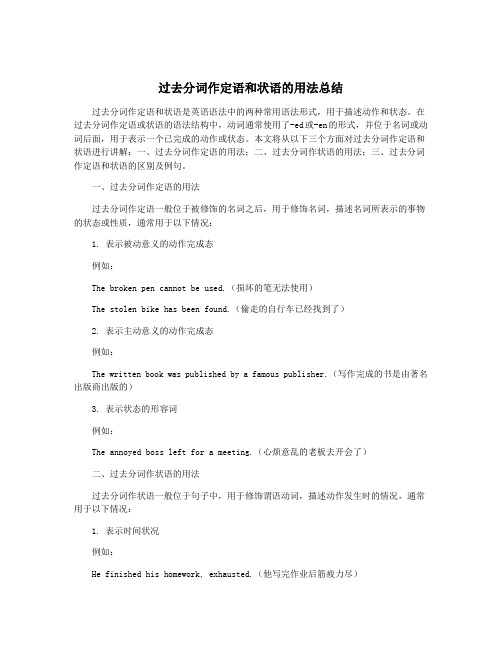
过去分词作定语和状语的用法总结过去分词作定语和状语是英语语法中的两种常用语法形式,用于描述动作和状态。
在过去分词作定语或状语的语法结构中,动词通常使用了-ed或-en的形式,并位于名词或动词后面,用于表示一个已完成的动作或状态。
本文将从以下三个方面对过去分词作定语和状语进行讲解:一、过去分词作定语的用法;二、过去分词作状语的用法;三、过去分词作定语和状语的区别及例句。
一、过去分词作定语的用法过去分词作定语一般位于被修饰的名词之后,用于修饰名词,描述名词所表示的事物的状态或性质,通常用于以下情况:1. 表示被动意义的动作完成态例如:The broken pen cannot be used.(损坏的笔无法使用)The stolen bike has been found.(偷走的自行车已经找到了)2. 表示主动意义的动作完成态例如:The written book was published by a famous publisher.(写作完成的书是由著名出版商出版的)3. 表示状态的形容词例如:The annoyed boss left for a meeting.(心烦意乱的老板去开会了)二、过去分词作状语的用法过去分词作状语一般位于句子中,用于修饰谓语动词,描述动作发生时的情况,通常用于以下情况:1. 表示时间状况例如:He finished his homework, exhausted.(他写完作业后筋疲力尽)She stood there, frozen with fear.(她站在那里,惊恐万分)2. 表示原因或结果例如:Having saved enough money, he bought a new car.(存够了钱,他买了一辆新车)Being late for the meeting, they missed their chance.(因为迟到,他们错过了机会。
)3. 表示条件状况例如:Having finished the task, he went home.(完成任务后,他回家了)三、过去分词作定语和状语的区别及例句过去分词作定语和状语的最大区别在于它们所修饰的词不同。
人教版高中英语同步语法精讲精练:过去分词作状语
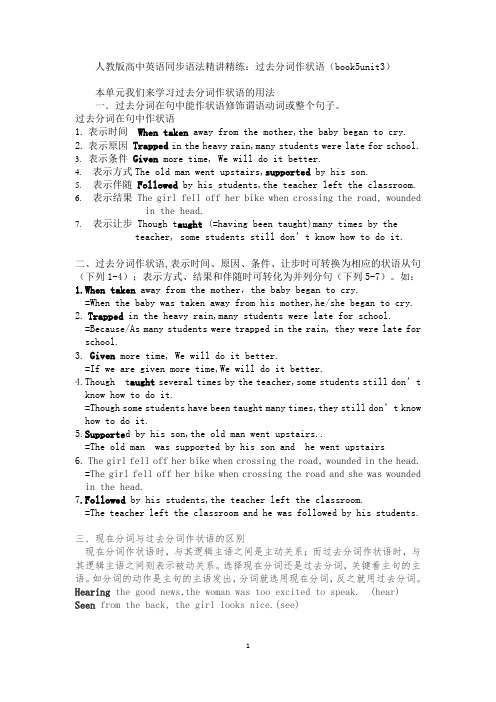
人教版高中英语同步语法精讲精练:过去分词作状语(book5unit3)本单元我们来学习过去分词作状语的用法一.过去分词在句中能作状语修饰谓语动词或整个句子。
过去分词在句中作状语1.表示时间When taken away from the mother,the baby began to cry.2.表示原因Trapped in the heavy rain,many students were late for school.3.表示条件 Given more time, We will do it better.4.表示方式The old man went upstairs,supported by his son.5.表示伴随 Followed by his students,the teacher left the classroom.6.表示结果The girl fell off her bike when crossing the road, woundedin the head.7.表示让步 Though t aught (=having been taught)many times by theteacher, some students still don’t know how to do it.二、过去分词作状语, 表示时间、原因、条件、让步时可转换为相应的状语从句(下列1-4);表示方式、结果和伴随时可转化为并列分句(下列5-7)。
如:1.When taken away from the mother,the baby began to cry.=When the baby was taken away from his mother,he/she began to cry. 2.Trapped in the heavy rain,many students were late for school.=Because/As many students were trapped in the rain, they were late for school.3. Given more time, We will do it better.=If we are given more time,We will do it better.4.Though t aught several times by the teacher,some students still don’t know how to do it.=Though some students have been taught many times,they still don’t know how to do it.5.Supporte d by his son,the old man went upstairs..=The old man was supported by his son and he went upstairs6. The girl fell off her bike when crossing the road, wounded in the head.=The girl fell off her bike when crossing the road and she was woundedin the head.7.Followed by his students,the teacher left the classroom.=The teacher left the classroom and he was followed by his students.三.现在分词与过去分词作状语的区别现在分词作状语时,与其逻辑主语之间是主动关系;而过去分词作状语时,与其逻辑主语之间则表示被动关系。
2020年高考英语易错题集锦 过去分词做状语

过去分词做状语一、要点精讲1.过去分词作状语,修饰谓语,说明动作发生的情况或背景,表示被动或完成的动作。
其逻辑主语一般应与句子的主语一致。
过去分词与句子主语之间通常存在逻辑上的动宾关系。
(1)过去分词的形式过去分词只有一种形式:donePraised by the neighbours,he became the pride of his parents.受到邻居们的表扬,他成为父母的骄傲。
(2)过去分词的否定式过去分词的否定形式由not+done构成Not given enough time ,he couldn’t finish the job on time.因为没有给他充分的时间,所以他没能按时完成工作。
2.过去分词的作用:过去分词用作状语时,可以表示谓语动作所发生的原因、条件、让步、伴随、时间等。
(1)She soon fell asleep,exhausted by the journey.(原因)由于旅途劳累,她很快就睡着了。
(2)Given more education,Tom’s EQ could be improved.(条件)如果多受教育的话,汤姆的情商可以提高。
(3)Repaired many times, the car still broke down on the road.(让步)虽然修了很多次,但这辆汽车还是在路上抛锚了。
(4)I finally reached the finishing line entirely exhausted.(伴随)我终于到达了终点,疲惫不堪。
(5)Asked about the result of his test,he made no answer.(时间)被问到他的测试结果时,他没有回答。
3.区分现在分词与过去分词分词作状语时,用现在分词还是过去分词,取决于分词与句子主语之间的关系。
主动关系用现在分词,被动关系用过去分词。
比较:Seeing from the top floor, we can find the garden more beautiful.Seen from the top floor, the garden looks more beautiful.4.作状语时,过去分词与现在分词被动式的区别过去分词可以用于表示条件,相当于一个被动的条件状语从句,但是现在分词的被动式一般不这样用。
高二英语必修五语法过去分词作状语
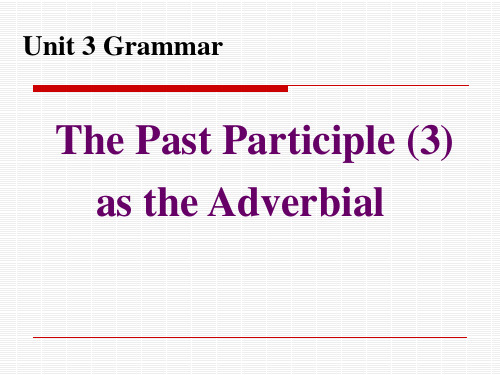
The teacher stood there, surrounded by the students.
Find out sentences with the same meaning from the text. 1. As I was worried about the journey,
-ed分词作状语, 表时间 =When the city is seen from the top of the hill,
the city looks like a big garden.
Summary 2
-ed分词做状语可表示时间、 原因、条件、让 步、方式、伴随等意义。这种-ed分词状语相 当于一个时间、原因、条件、让步等状语从句。
3. As I was exhausted, I slid into bed and fell fast asleep. Exhausted, I slid into bed and fell fast asleep.
Practice: Change the following clauses into Past Participles.
3.(_A_l_th_o_u__g_h_)L__a_u_g_h_e_d_a_t__b_y_m__a_n_y_p__eo_p__le_(尽管 被许多人嘲笑), he continued his study. (laugh) -ed分词作状语, 表让步
4.The teacher stood there _s_u_r_r_o_u_n_d_e_d__b_y___ m__a_n_y_s_t_u_d_e_n_t_s(被许多学生包围着). (surround) -ed分词作状语, 表伴随或方式
人教版英语必修五语法过去分词作状语
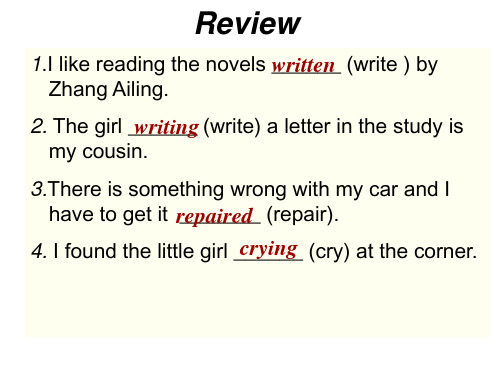
过去分词作方__式__或__伴_随__状语
作状语表示方式或伴随情况时,过去分词可用 并列句代替。
(3) 有些过去分词(短语)源于系表结构, 作状语时不表动作而表状态。
moved/pleased/disappointed/worried…
be dressed in
be seated
be lost in沉浸在 be prepared for
be devoted to 致力于 be determined to do
It is a TV program, which is a surprisingly popular singing talent show broadcast on Zhejiang SatelliteTV since July 13, 2012 . Chosen to act as one of the four judges on it, Na ying is much more famous thashe was late, Wendy went red in the face. → When Wendy was asked why she was late, she went red in the face.
b. Left at home, John didn't feel afraid at all.
过去分词作_原__因__状语
Done in a hurry, his homework was full of mistakes. →Because it was done in a hurry, his homework was full of mistakes.
高中英语语法 过去分词作状语

3.Because he was seriously injured , he had to be taken to hospital. = Seriously injured , he had to be taken to hospital. 4.Because it was written in a hurry, this article was not so good. = Written in a hurry, this article was not so good.
归纳: 过去分词作方式或伴随状语,可 转换为并列句。
练习1: P46 练习2:还原 1._____(ask) about his family, he made no answer. 2.____ (see) from the top of the hill, the city looks more beautiful. 3.seriously ____ (injure) , he had to be taken to hospital. 4._____ (write) in a hurry, this article was not so good.
与Ving作状语的区别
1.He picked up a wallet while he was walking home. =He picked up a wallet while walking home. 2.While we were swimming in the river, we saw a fish jump out of the river. =While swimming in the river, we saw a fish jump out of the river.
人教高中英语 必修5unit3过去分词作状语
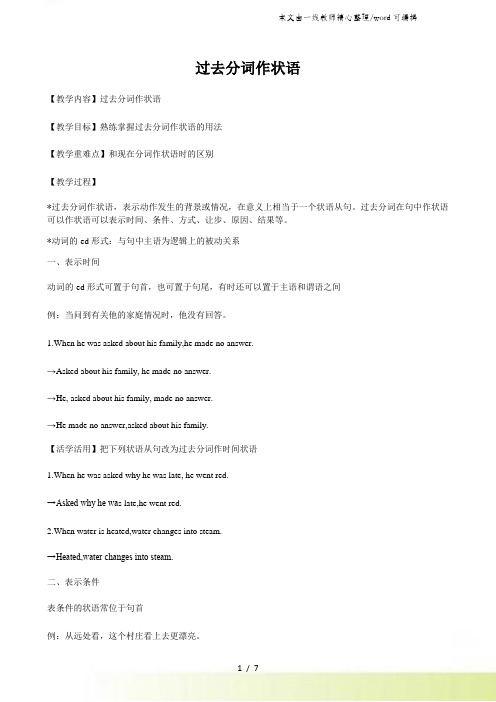
过去分词作状语【教学内容】过去分词作状语【教学目标】熟练掌握过去分词作状语的用法【教学重难点】和现在分词作状语时的区别【教学过程】*过去分词作状语,表示动作发生的背景或情况,在意义上相当于一个状语从句。
过去分词在句中作状语可以作状语可以表示时间、条件、方式、让步、原因、结果等。
*动词的-ed形式:与句中主语为逻辑上的被动关系一、表示时间动词的-ed形式可置于句首,也可置于句尾,有时还可以置于主语和谓语之间例:当问到有关他的家庭情况时,他没有回答。
1.When he was asked about his family,he made no answer.→Asked about his family, he made no answer.→He, asked about his family, made no answer.→He made no answer,asked about his family.【活学活用】把下列状语从句改为过去分词作时间状语1.When he was asked why he was late, he went red.→Asked why he wa s late,he went red.2.When water is heated,water changes into steam.→Heated,water changes into steam.二、表示条件表条件的状语常位于句首例:从远处看,这个村庄看上去更漂亮。
1.If the village is Seen in the distance, the village looks more beautiful.→ Seen in the distance, the village looks more beautiful.【随即随练】把下列状语从句改为过去分词作条件状语1.If we were given more time and money,we would have done the work better.→Given more time and money,we would have done the work better.2.If I was compared with you, I still have a long way to go.→Compared with you, I still have a long way to go.三、表示原因表示原因的分词短语一般置于句首,偶尔置于句尾或句中例:1.由于伤得严重,只好把他送往医院。
高中英语过去分词用法详解
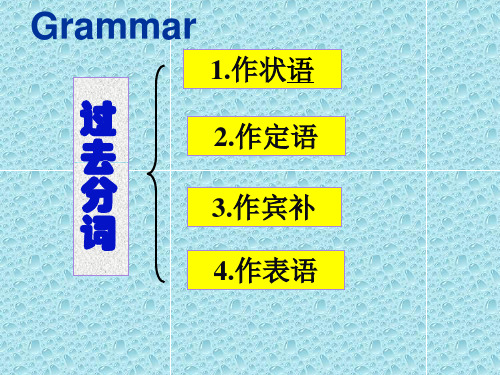
3. Well known for his expert advice, he received many invitations to give lectures.
→Because he was well known for his expert advice, he received many invitations to give lectures., 且与主语 之间存在着被动关系。过去分词作 状语可表时间、原因、 让步、 结果、 方式、 条件等。
观察下列的句子:
Once published, his works (=Once his works was published, ) became famous for the absence of rhyme at the end of each line.
3) If _tr_a_p_p_e_d_ in a burning building, you should send for help. 4) Although _s_h_o_t in the leg, he continued firing at the police.
二、过去分词作定语 过去分词作定语与其所修饰的词之间
B. Seen
4. 从太空看, 宇航员看不到长城。
__A__ from the space, the astronaut
can not discover the Great Wall.
A. Seeing
B. Seen
Difference between the Present Participle and the Past Participle _U_s_e_d_for a long time, the book looks old. 由于用了很长时间,这本书看上去很旧. _U_s_i_n_g_ the book, I find it useful. 在使用的过程中,我发现这本书很有用. _L_o_o_k_i_n_g_ at her, he jumped with joy. _L_o_o_k_e_d_at by her, he jumped with joy.
- 1、下载文档前请自行甄别文档内容的完整性,平台不提供额外的编辑、内容补充、找答案等附加服务。
- 2、"仅部分预览"的文档,不可在线预览部分如存在完整性等问题,可反馈申请退款(可完整预览的文档不适用该条件!)。
- 3、如文档侵犯您的权益,请联系客服反馈,我们会尽快为您处理(人工客服工作时间:9:00-18:30)。
用括号内所给动词的适当形式填空。 1. __U_s_ e(duse) in this way, the word shouldn’t be taken as a verb. 2. __A__r_m__e(darm) with special guns, knives and brushes, two space walking astronauts practiced fixing the spacecraft. 3. Though ___c_a__u_g(hctatch) in a traffic jam, we managed to arrive at the airport. 4. Susan is not easy to get along with. But once _____ (ggaainine)d, her friendship will last forever.
2. 表示原因
表示原因,相当于由as, since, 或because 引导的原因状语从句.
Exhausted, the children fell asleep at once. =As they were exhausted, the children fell… Caught in a heavy rain, he was wet to the skin. =Because he was caught in a heavy rain, he
注意:可在过去分词前加上连词when, while, until等来强调过去分词所表示的动 作与主句谓语动词所表示动作的时间关系。
1. When it is heated, ice will be changed into water. When heated, ice will be changed into water.
1.过去分词作时间状语
1. Seen under a microscope, a fresh snowflake has a delicate (精美的) shape.
When it is seen under a microscope, a fresh snowflake(雪花) has a delicate shape.
1.Worried about the journey, I was unsettled for the first few days. As I was worried about the journey, I was unsettled…
2.Well-known for their expertise, his parents’ company, called “Future Tours”, transported me safely into the future in a time capsule. Since his parents’ company was well-known for…
过去分词作状 语的用法
过去分词作状语: 过去分词作状语修
饰谓语动词,可以表示_时__间__、_原__因_、 _条__件_、__让__步_、__行__为__方__式或___伴__随__情_等况, 在意义上相当于状语从句。
Find out sentences using V-pp as the adverbial in the text.
3. Hit by the lack of fresh air, my head ached. Because I was hit by the lack of fresh air, my head ached.
4.Exhausted, I slid into bed and fell fast asleep. As I was exhausted, I slid into bed and ...
2.Seen from the top of the hill, the city looks like a big garden. When it is seen from the top of the hill, the city looks…
Asked many times, he began to feel bored. After he was asked many times, he began to…
4. 表示让步
表示让步,相当于although/though引导的让
步状语从句. ughed at by many people, he continued his study. Though he was laughed at by many people,
he continued his study. 2.Badly wounded, he continued to fight. Though he was badly wounded, he continued
2.She was in tears as if deeply moved by the moving film. =She was in tears as if she was deeply moved by the moving film.
The film star appeared, surrounded by a g件,相当于if, unless引导的条件状语 从句 Heated, water changes into steam. =If it is heated, water changes into steam. Given another chance, he will do better. =If he is given another chance, he will do better.
to fight.
5. 表示方式或伴随
过去分词作方式状语或伴随状语时,相当于一 个并列分句,没有相应的从句可替换. 1.The old man entered the meeting room, supported by a young fellow. =The old man entered the meeting room and was supported by a young fellow.
